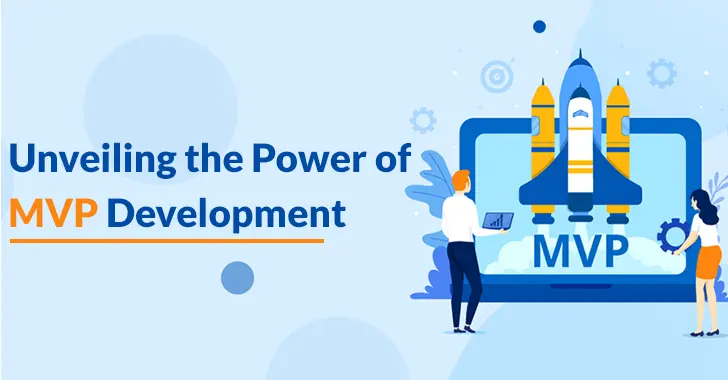
Unveiling the Power of MVP Development
Successful product development does not occur by accident. It requires strategic planning, informed decision-making, and, frequently, beginning on a modest scale.
MVP development is acquiring popularity among entrepreneurs due to its transformative force in the creation of successful products.
Table of Contents
The Genesis of MVP Development
Minimum Viable Product, or MVP, is a technique for product development that entails creating a product with just enough features to appease early consumers while also gathering feedback for future product development. It is about proving a theory, acquiring insightful knowledge, and avoiding unnecessary complications. Keeping the emphasis on what genuinely matters – delivering value – is essential.
Why MVP Development Matters
Creating a business in the United States or anywhere else in the world requires tenacity, determination, and a comprehensive market comprehension. Before investing significantly in full production, MVP development enables you to evaluate your product concept in real-world market conditions.
A Data-Driven Approach
Minimum Viable Product (MVP) Development is a progressive and systematic approach to product creation. This innovative technique breaks down into the following steps:
Concept Initiation: At its core, MVP development begins with an idea. A simple, clear vision for a product that addresses a particular market need or problem.
Feature Identification: Next, MVP development requires you to outline the fundamental features that will deliver value to the customers. These core attributes are the bare minimum that your product needs to solve the problem at hand.
Development Phase: After identifying the basic features, the development of these core attributes begins. Remember, the goal is not to offer a feature-rich product at this stage, but to test the feasibility and market receptivity of the concept.
Market Testing: Once the MVP is developed with the primary features, it’s launched to a segment of your target audience. This stage allows you to gauge user response and get actionable feedback for further product enhancement.
Feedback Integration: Lastly, based on the market feedback, you make iterations to the product. The idea is to refine your MVP continuously, incorporating feedback and new understanding until the product fits the market perfectly.
Embracing MVP development in your product creation process can guide your efforts in the right direction and set you on a path towards delivering value and solving real market problems.
Agility in Business
The development of a minimum viable product (MVP) promotes an agile business strategy, allowing you to pivot rapidly based on feedback from your initial consumers. This model permits iterative enhancements, resulting in a product that is significantly more in line with market demands.
Navigating the Path of MVP Development
The journey towards MVP Development is a meticulous process that requires both strategic planning and reactive adjustments. This course can be broken down into several distinct yet interconnected stages.
Phase 1 is laying the Foundation
Identifying the most important components of your MVP is the foundation of your development process. This is not about creating a completely developed product, but rather about laying the groundwork for your offering.
Needs Assessment: Start by identifying the issue that your product intends to solve. Recognize your target audience’s specific problem areas.
Key Attributes: Identify the essential features your product must have to effectively resolve these pain factors. It is essential to rank these characteristics based on their value proposition and relevance to your target audience.
Phase 2 is the development phase
Following the foundation, the actual development of the MVP follows. This phase involves turning your concepts into a physical product.
Lean Development: Utilize lean methodologies to develop your minimum viable product. The objective here is to create the simplest iteration of your product that still provides value to the end user.
Resource Management: At this stage, it is crucial to remember that the MVP is not the final product, but rather a test version. Therefore, it is important to manage resources effectively.
Phase 3 is about MVP Launch and Feedback Loop
It is time to launch your MVP to a subset of your target audience once it is complete. This phase is essential for gathering initial user feedback and gaining insight into your product’s efficacy in the actual world.
Launch: Introduce your minimum viable product to the market and pay close attention to how users interact with it.
[Rapid Response Collection:] This phase is not only about launching your MVP but also about gaining insights from it. Collect user feedback, observe their behavior, and comprehend their preferences.
Pase 4 is about iteration and improvement
After collecting enough feedback and gaining sufficient insights, you will need to incorporate these lessons into your product.
Refining the Product: Based on the feedback you’ve received, make the necessary adjustments to your product. It could involve introducing new features, modifying existing ones, or eliminating certain aspects.
Evaluation Iterations: Each new version of your product must also be tested, with the cycle of feedback and development continuing until your product is truly market-ready.
Phase 5 is Expansion
Once your MVP has matured into a marketable product, it is time to scale up.
Growth Strategies: You can now concentrate on broader marketing strategies, sales plans, and customer retention initiatives.
Continuous Improvement: Remember that your product will require continuous refinement even at this stage. Over time, your audience, market conditions, and competition will change, and your product must adapt accordingly.
This distinctive MVP development process combines planning, execution, feedback, and continuous improvement. These steps can pave the way for a product that not only satisfies market demands but also sets out from the competition.
The Power of MVP Development: A Case Study
One shining example of the power of MVP development is Dropbox. They started with a simple video demonstrating their product concept, which garnered substantial interest.
This early validation of their product concept allowed them to secure funding for further development and, ultimately, become a multi-billion dollar company.
Final Thoughts
In conclusion, MVP development is an effective strategy for entrepreneurs in the United States and abroad. It reduces the risks associated with introducing a new product and provides valuable market demand information.
By concentrating on the most valuable features and embracing an iterative development process, it is possible to create a genuinely successful product. Steve Jobs once stated, “Innovation differentiates a leader from a follower.” Innovations such as MVP development are at the forefront of product development.
Codica provides comprehensive services that guide you through each stage of the MVP development process for a deeper journey into its practical aspects.
In the tumultuous world of business creation, MVP development may be the key to unlocking long-term success. Embrace the power of MVP and create the conditions for the success of your product.


